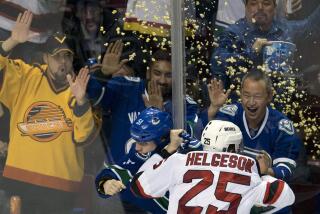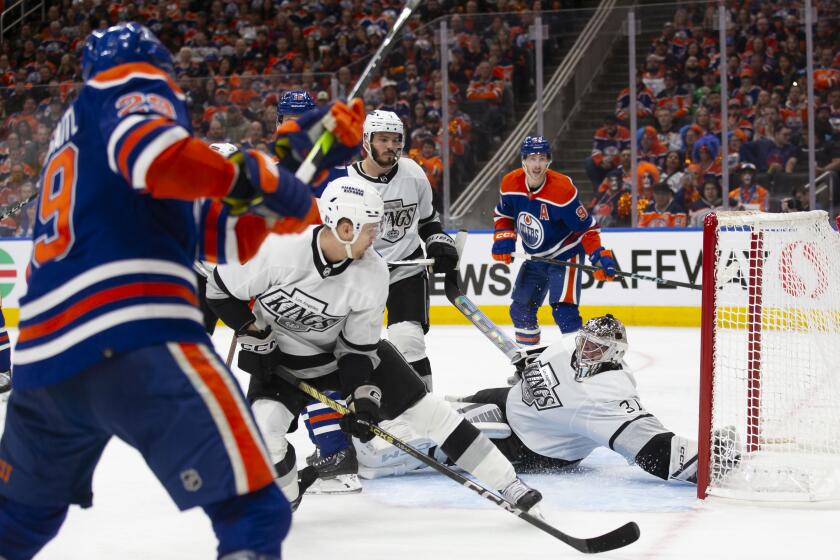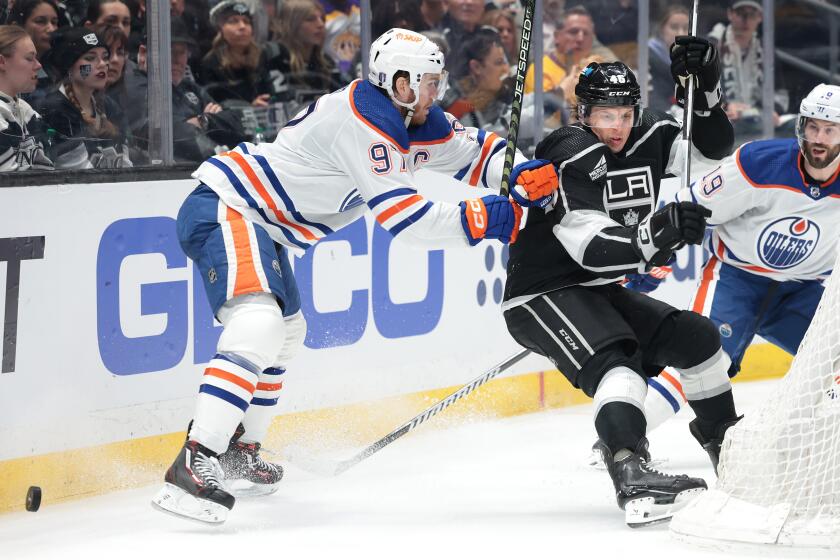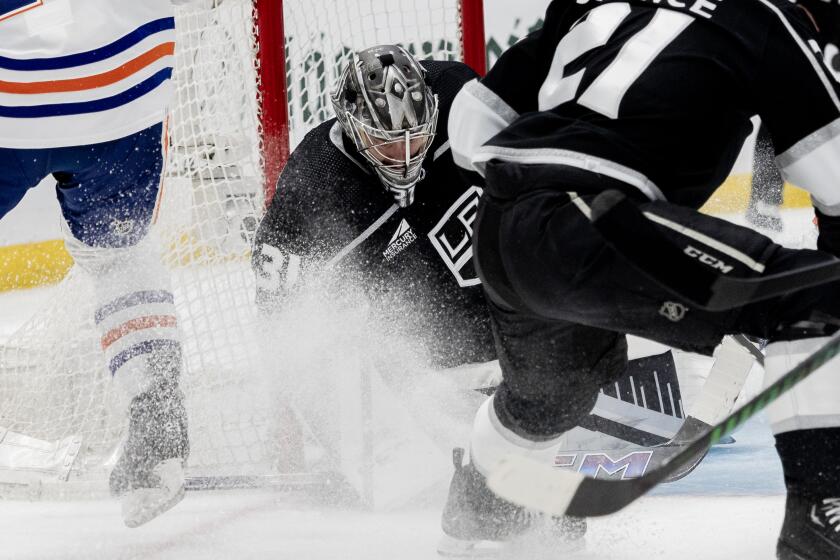Column: Gimmick or not, the NHL shootout remains a big part of the game

It’s the essence of hockey distilled into one breathless moment: a goaltender, a shooter, and nothing between them but tension and the hopes of thousands of fans, many of them brought to their feet by the dramatic circumstances.
Often mocked as a skills contest but promoted by the NHL as fan-friendly entertainment, the shootout was adopted before the 2005-06 season for regular-season games as a way to eliminate ties. In the 2003-04 season — the last in which ties were permitted — 14% of regular-season games ended in ties. Awarding an extra point to the winner on top of the point each team is guaranteed for reaching overtime was designed to encourage coaches to go for wins.
Of the 907 games played this season through Wednesday, 127 (14%) have gone to shootouts. Bottom line: They are important.
“Especially now, the last four, five six years, every team takes shootouts more and more seriously,” said Florida Panthers left wing Jussi Jokinen, who ranks ninth for his career among active skaters with 35 shootout goals.
“It has to be that way. Those points can be the difference whether they make the playoffs or not. ... That could be the difference in whether you have a job next year.”
For some teams, such as the Kings this season, the shootout is pure torture. They’re 1-7 in shootouts and have scored on only two of 28 shots, a league-low 7.1%. That’s seven points lost, and in their Pacific Division teams No. 2 through No. 5 were separated by five points heading into Thursday’s games.
The top three teams in each division qualify for the playoffs, along with the two remaining teams in each conference with the most points. Those teams battling for the final spots are all a few points apart.
For some teams, the shootout has been a boost. The Ducks and the Chicago Blackhawks share the league lead with eight shootout wins each. The Blackhawks have converted 16 of 33 shots (48.5%) and the Ducks have scored on 19 of 40 (47.5%).
The Ducks owe a chunk of their success to Jakob Silfverberg, the 24-year-old who’s pretty much money in the shootout bank. He leads the NHL this season with nine shootout goals scored in 13 attempts. That’s a crazy 69.2% success rate. For his career, he’s 14 for 23 (60%). Chicago center Jonathan Toews is the active career shootout leader with 40 goals, scored in 79 attempts (50.6%).
“I think it’s always an advantage for the young guys, the new guys to come in,” Jokinen said. “When I come in, all the goalies know my moves. I have no secrets anymore. To be honest, the last three, four years, I haven’t been that good. Obviously, the first three or four years, I had a really good run there. But, nowadays, it’s tough, the goalies know my moves and where I’m most comfortable.”
Silfverberg is most comfortable simply relying on his quick release and hard shot.
“I don’t think there’s a secret,” Silfverberg said. “I just try not to think about it too much, other than having a plan when I go out there and try to execute it. If it works, it works, and so far it’s been working pretty well. That’s the main thing: not to overthink it.”
Silfverberg said he plots “what is right,” before he moves toward the goalie rather than relying on a goalie’s movement.
“I have a plan before I go most often, but obviously, if the goalie is super far out, you might have to change that,” Silfverberg said. “Nine times out of 10, I make my decision before I go.”
The NHL has tinkered with the shootout format since it was introduced. This season’s big change banned “spinorama” moves, fancy maneuvers fans loved but NHL executives said didn’t advance the puck. The league has modified overtime rules in an effort to settle more games in sudden-death play and a few general managers advocate doing that by playing three-on-three in the five-minute overtime instead of four-on-four. Three-on-three might be too radical, so for now, love it or hate it, the shootout endures — and you better be prepared for it.
Philadelphia forward Wayne Simmonds, who has scored on four of five shots this season, said the Flyers’ goalie coach, Jeff Reese, has worked diligently to make players familiar with opposing goalies’ tendencies.
“You want the goaltender to make the first move and then you have him,” Simmonds told the Delaware (Pa.) County Times. “If you make the first move, the goalie will just follow you over. You’re dead in the water. So you have to try to make the goalie make the first move and use your instincts from there.”
It’s also a battle of wills.
“It’s a mental battle against the goalie,” said Jokinen, “whether you try the No. 1 move or you try to make the goalie think you’re going to try that and try something else.”
Also consider what has to be on coaches’ minds — Who does well against which goalie? Who’s going to take the shots? In what order should they shoot? What’s going to get us that point?
As for the goalies, it’s all in their crease. And Ducks Coach Bruce Boudreau knows when to keep his mouth shut.
“The minute I tell them, ‘Hey, listen, this guy’s gonna shoot,’ he dekes. Then I’ll feel like an idiot,” Boudreau said.
Jokinen said shooters were put at a disadvantage when the NHL eliminated the ice-grooming “dry scrape” between the end of regulation and start of overtime. That adversely affects the ice by the time the shootout starts in warm places like Florida, Los Angeles and Anaheim.
“You have to take that in your thought process too,” he said. “The ice is going to be very, very bad and the goalies are practicing the shootouts more and more and they’re getting better. It’s not easy to score in the shootouts.”
The career save percentage leader among goalies who faced 100 or more attempts is Mathieu Garon at 75.2 (82 of 109). The highest career save percentage among active goalies who have faced at least 75 shots is the 74.9 compiled by Henrik Lundqvist of the New York Rangers (245 of 327).
“We have the goalie coach,” Jokinen said. “We always go to him before the game and he knows the last 15 shootout tries for [Kings goaltender Jonathan] Quick and you can discuss with him what he thinks and what you think,” Jokinen said.
“It’s getting much more difficult for both sides. I’m sure Quick is doing the same thing. He’s looking at our top three or four shooters and seeing what kind of moves we have.”
The difficulty is making sure the shootout doesn’t move a team out of playoff contention, something the defending Stanley Cup champion Kings have battled this season.
“I don’t know what it is,” said center Anze Kopitar, who ranks 13th among active skaters on the career shootout list with 30 goals but is 0 for 7 this season. “If we knew, we’d break out of it.”
But there is one consolation for those who move on: There are no shootouts in the playoffs, where unlimited overtime is the rule.
helene.elliott@latimes.com
Twitter: @helenenothelen
Times staff writers Lisa Dillman and Lance Pugmire contributed to this report.
More to Read
Go beyond the scoreboard
Get the latest on L.A.'s teams in the daily Sports Report newsletter.
You may occasionally receive promotional content from the Los Angeles Times.






